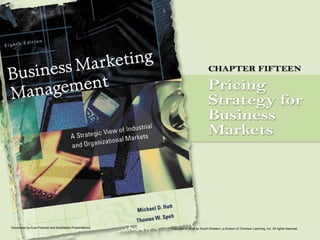Ch15
- 1. Developed by Cool Pictures and MultiMedia Presentations Copyright © 2004 by South-Western, a division of Thomson Learning, Inc. All rights reserved.
- 2. Benefits of a Particular Product
Functional benefits are the design characteristics
that might be attractive to technical personnel.
Operational benefits are durability and reliability,
qualities desirable to production managers.
Financial benefits are favorable terms and
opportunities for cost savings, important to
purchasing managers and controllers.
Personal benefits are organizational status,
reduced risk, and personal satisfaction.
Developed by Cool Pictures and MultiMedia Presentations Copyright © 2004 by South-Western, a division of Thomson Learning, Inc. All rights reserved.
- 3. •A broad perspective needed in examining the costs a particular
alternative may present for the buyer.
•Rather than making a decision on the basis of price alone,
organizational buyers emphasize the total cost in use of a particular
product or service.
Customers’ Cost-in-Use Components
Developed by Cool Pictures and MultiMedia Presentations Copyright © 2004 by South-Western, a division of Thomson Learning, Inc. All rights reserved.
- 4. Key Components of the Industrial
Pricing Process
•There is no easy formula for
pricing an industrial product or
service.
•The decision is multidimensional.
•The each interactive variable
assumes significance. Fig. 15.2
Developed by Cool Pictures and MultiMedia Presentations Copyright © 2004 by South-Western, a division of Thomson Learning, Inc. All rights reserved.
- 5. Price Objectives
• The pricing decision must be based on
objectives congruent with marketing and overall
corporate objectives.
• The marketer starts with principal objectives
and adds collateral pricing goals:
1. Achieving a target return on investment,
2. Achieving a market-share goal,
3. Meeting competition.
Developed by Cool Pictures and MultiMedia Presentations Copyright © 2004 by South-Western, a division of Thomson Learning, Inc. All rights reserved.
- 6. The equation highlights how the relative perceived values of two competing
offerings are compared.
The premium price differential, or perceived relative value, can be broken
down into components based on each important attribute:
1. the value of the attribute to the buyer,
2. the perception of how competing offerings perform on that attribute.
Relative Perceived Value of Two Product Offerings
Developed by Cool Pictures and MultiMedia Presentations Copyright © 2004 by South-Western, a division of Thomson Learning, Inc. All rights reserved.
- 7. Price Elasticity of Demand
• The rate of percentage change in quantity
demanded attributable to the percentage change
in price.
• Factors of price elasticity,
– The ease with which customers can compare
alternatives.
– The importance of the product in the cost
structure.
– The value that the product represents to a
customer.
Developed by Cool Pictures and MultiMedia Presentations Copyright © 2004 by South-Western, a division of Thomson Learning, Inc. All rights reserved.
- 8. Target
Costing
Target costing features a design-to-cost philosophy that begins by
examining market conditions:
– Identifies and targets the most attractive market segments.
– Determines what level of quality and types of product attributes
will be required to succeed.
Developed by Cool Pictures and MultiMedia Presentations Copyright © 2004 by South-Western, a division of Thomson Learning, Inc. All rights reserved.
- 9. Cost Classification System Goals
1. Properly classify cost data into their fixed and
variable components.
2. Properly link them to the activity causing them.
Developed by Cool Pictures and MultiMedia Presentations Copyright © 2004 by South-Western, a division of Thomson Learning, Inc. All rights reserved.
- 10. Analysis of Cost Concepts
1. Direct traceable or attributable costs.
2. Indirect traceable costs.
3. General costs.
Developed by Cool Pictures and MultiMedia Presentations Copyright © 2004 by South-Western, a division of Thomson Learning, Inc. All rights reserved.
- 11. Sources of the Experience Effect
1. Learning by doing.
2. Technological improvements.
3. Economies of scale.
Developed by Cool Pictures and MultiMedia Presentations Copyright © 2004 by South-Western, a division of Thomson Learning, Inc. All rights reserved.
- 12. Selected
Cost
Comparison
Issues:
Followers
Versus the
Pioneer
Under certain conditions, followers into a market may confront lower
initial costs than did the pioneer. By failing to recognize potential cost
advantages of late entrants, the business marketer can dramatically
overstate costs differences.
Developed by Cool Pictures and MultiMedia Presentations Copyright © 2004 by South-Western, a division of Thomson Learning, Inc. All rights reserved.
- 13. Pricing New Products
Skimming
– Appropriate for a distinctly new product, provides the firm with an
opportunity to profitably reach market segments that are not
sensitive to the high initial price.
– Enables the marketer to capture early profits.
– Enables the innovator to recover high developmental costs more
quickly.
Penetration is appropriate when there is
1. High price elasticity of demand,
2. Strong threat of imminent competition,
3. Opportunity for a substantial reduction in production costs as
volume expands.
Developed by Cool Pictures and MultiMedia Presentations Copyright © 2004 by South-Western, a division of Thomson Learning, Inc. All rights reserved.
- 14. The Rules of Competitive Strategy
• Never participate in a competitive engagement
you cannot win.
• Always participate in competitive engagement
from a position of advantage.
Developed by Cool Pictures and MultiMedia Presentations Copyright © 2004 by South-Western, a division of Thomson Learning, Inc. All rights reserved.
- 15. Competitive Bidding
• Closed bidding, often used by business and
governmental buyers, involves a formal
invitation to potential suppliers to submit written,
sealed bids for a particular business opportunity.
• Open bidding is more informal and allows
suppliers to make offers (oral and written) up to
a certain date.
Developed by Cool Pictures and MultiMedia Presentations Copyright © 2004 by South-Western, a division of Thomson Learning, Inc. All rights reserved.
